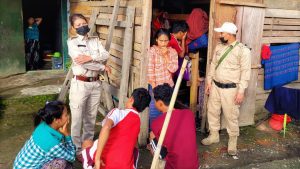As many as eighty-five Myanmar nationals were arrested in the Indian border state of Manipur following a series of crackdowns in the last two months, fueling speculation over the reasons that prompted the government to crack the whip.
On June 28, 80 Myanmar nationals including 20 children were arrested in Churachandpur, a district in Manipur bordering Myanmar, and sent to judicial custody in Imphal. Five children were lodged at an observation home in the district.
According to some locals in Churachandpur district, the refugees had arrived from Mizoram, another border state in India, where more refugees from Myanmar have taken sanctuary.
Then on August 10, five Myanmar nationals including a woman were arrested from the same district on the charge of illegal intrusion. A senior police officer denied it was a crackdown on the refugees in Churachandpur but a “routine procedure” after complaints were received against foreign nationals in the district.
The government action provoked diverse reactions in the state, with the Citizens Committee Manipur appealing to the government for a “smarter and more humane approach” to the refugee crisis. It has made a case for the issue of identity cards to Myanmar nationals living in the state and called for the setting up of designated camps with basic facilities.
Estimates of the number of Myanmar refugees in Manipur range between 5,000 and 10,000. The differences notwithstanding, large sections of the Meiteis and Nagas – two dominant communities in Manipur – are concerned over the influx of people with a cultural affinity to the Chin tribes in Myanmar as it could upset the delicate ethnic balance in the state.
“The refugees are from the Kuki-aligned Chin tribes, such as the Zou. Right now in Manipur, both among many Meiteis as well as Nagas, there seems to be a concern about the spreading Kuki population,” Pradip Phanjoubam, commentator and editor of Imphal Review of Arts and Politics told The Diplomat. “Though there have been alarmist reports of influx, in terms of numbers, it is not really much. This should have been obvious because the neighboring Chin State in Myanmar is very sparsely populated, much less than on the Indian side,” he said, pointing out that it is “never going to be in the dimension of illegal migration from Bangladesh.”
A middle-rung functionary of the ruling Bharatiya Janata Party (BJP) in Manipur said that the recent crackdown was aimed at “delivering a message” to Myanmar nationals wanting to migrate to India. “There are certainly more Myanmarese nationals in Manipur than those who were arrested recently. Many of them have settled down in different districts. So this crackdown was for discouraging more people to cross the border into Manipur,” he told The Diplomat on condition of anonymity.
Meanwhile, Manipur Chief Minister N Biren Singh has also warned that villages with less than 50 households would not be recognized by the government. In a reply to a question raised in the state assembly, he referred to the unlawful conduct of some officials in tagging some new settlements as villages without following the prescribed procedure. At least 20 such cases were unearthed in Churachandpur.
Manipur shares a long border of 398 kilometers with Myanmar’s Sagaing Division and Chin State, which are among the areas putting up the strongest resistance to the military regime. Hundreds have been killed and thousands rendered homeless as a result of the raids conducted by the army against the People’s Defense Forces (PDFs) and their strongholds. In some places, the military has deployed jet fighters and helicopter gunships for attacks on towns and villages.
The situation in Manipur prompted 19 tribal organizations to submit a memorandum to Prime Minister Narendra Modi last month demanding the creation of a citizens’ register to check illegal immigration into the state. It came close on the heels of a similar appeal made to Chief Minister Singh in June by the United Naga Council (UNC) and the Coordinating Committee on Manipur Integrity (COCOMI) for urgent steps to check the influx.
The Meiteis, the majority Hindu community in the state, have been concerned over their declining numbers in the past few decades. According to the 2011 census, they comprised 51 percent of the state’s total population, down from 66 percent in 1971.
As a solution to the tricky situation, several organizations are demanding some sort of protective legislation for the Meitei community, such as according it with Scheduled Tribe (ST) status, which would bestow it with certain rights enjoyed by other groups in the category such as the Nagas and Kukis.

































